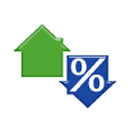Price Growth of Homes Continues to Struggle

Home sales in London outpaced other regions in England and Wales by 22 per cent in August, according to the latest LSL/Acadametrics House Price Index. While average house prices inched up a mere 0.2 per cent across the UK. Home price growth is expected to continue its turtle pace as 2010 increases will be short of matching that of a year ago.
David Brown, LSL commercial director, offered insight about buying and selling and housing costs within the industry, saying: "The pickup in house sales since the start of the year dropped off in August. The exception is London where high demand for prized property from cash-rich buyers has seen housing market activity increase. Some buyers will be wary of imminent public sector cuts and the knock-on consequences for the economy. "In the short term we expect small fluctuations but no significant dip in the wider market. Regional differences may be quite stark as some areas of the country feel the effect of cuts more than others. Active first-time buyers are the key to a healthy housing market and most are waiting for more attractive products from lenders before they make a move. "Lending has been broadly flat and house price growth has slowed, with neither likely to pick up again until positive economic news helps to ease lending conditions. Lenders and the government must perform a financial balancing act to ensure supply does not begin to pull away from demand." Housing market specialist and Chairman of Acadametrics, Dr. Peter Williams, remarked about specific details concerning pricing, mortgage, remortgage and the possibility of a double dip recession and its effects on the market, saying:"The average price of a home in England & Wales is now £222,454. At this level, it is down £9,374, or 4.0%, from its peak in February 2008 of £231,828. When prices are largely static, as now, those transactions reported to the Land Registry after some months delay can swing small changes in the average house price from plus to minus and vice versa. Thus, further data emerging from Land Registry have modified our reported month on month price increases for May, June and July 2010, amounting, in our previous reporting, to an aggregate -0.1% ©. £220) fall for the three months. The additional data result in a +0.5% (£980) increase over the period, an outcome which is also reflected in our reported 0.2% rise in prices for August (based on our index of indices forecast). "Our practice, as above, is to maintain a constant update until the effect of every transaction has been recorded. Assuming no further significant change, nominal house prices have fallen by a mere -0.3%, since March 2010. Hence, to all intents and purposes, the market has been static with minor monthly oscillations. Our annual rate of growth at 7.7% reflects past price changes rather than activity in more recent months and, as earlier months drop out from the annual calculations, we will see the annual rate of growth continue to fall over the remainder of the year. "The price indices published so far for August, plus a number of forecasts, show that views of both the present and the future remain very mixed and highly dependent upon the reporting base and modeling assumptions. Given the volatility shown in sample-based indices, we would caution against reporting each release as a one-off. Specifically, the mortgage-based indices do not include prices for cash purchases, and possibly exclude some of those of higher priced homes. Whilst the lender indices have a deserved reputation in indicating change, our index, based upon all prices, does not show that prices, as reported on the Land Register, are falling such that a double dip in prices is already occurring, and nor does the CLG index which is based upon completion prices. We report how the prices reported by the lenders early in the transaction cycle relate to the final prices, allowing a two or three months delay, in our Quarterly Comparison of Indices. "Whilst the possibility of falls certainly exists, much will turn on what happens to the wider economy both here and in the USA. Falls are reported in the reservations for new homes and the Bank of England Trends in Lending report for August suggested that mortgage lending for home purchases and remortgaging was broadly flat. Offsetting these clear negatives are the continuing unmet demand for housing, the steadily growing shortfall in newly built homes and the evidence of strong local and regional variations. Much turns on area and property type and there are some active markets where prices continue to rise. Given the negativity that surrounds the market, it behooves buyers to choose carefully; we discuss this in detail in our section on regional analysis. "What the overall position suggests is that we will continue to experience a market which is flat. If, however, the economy turns down sharply and interest rates are pushed up, we can expect to see the housing market weaken significantly and even to see the double dip. If, however, the UK economy avoids a dip and growth recovers, the possibility exists of quite strong house price growth, especially if mortgage supply is restored."



